When you choose the best height for solar street lights, you improve both lighting and safety. For residential areas, a solar street light height of 3 to 7 feet works well. In commercial zones, aim for 10 to 20 feet. Highways need 20 to 50 feet, while parks may use poles from 40 to 100 feet. The right height lets streetlights cover more area, reduce dark spots, and help keep people safe. Installing at the best height also ensures the light meets local needs and adapts to weather or obstacles.
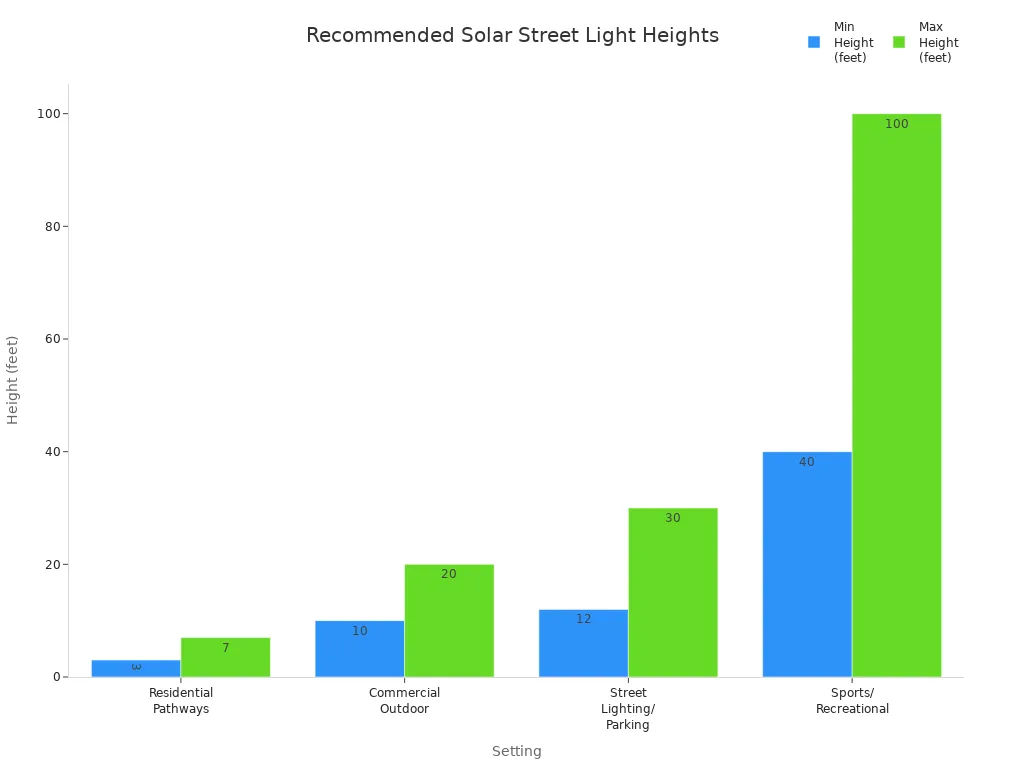
Key Takeaways
Best Height Overview
Standard Solar Street Light Height
When you plan a solar street lighting project, you need to know the standard height of street light poles for different areas. International lighting organizations have set clear guidelines for the height of solar street lights based on the type of street or area. These standards help you achieve the best height for safety, visibility, and energy efficiency.
Here is a table that shows the standard height of street light poles for various street types:
| Context / Street Typology |
Standard Pole Height Range (meters) |
| Sidewalks and bike facilities |
4.5 – 6 |
| Narrow streets (residential, commercial, historical) |
8 – 10 |
| Wider commercial or industrial streets |
10 – 12 |
You can see that the typical height range for solar street lights falls between 4 and 12 meters. For sidewalks and bike paths, you should use poles between 4.5 and 6 meters. Narrow streets in residential or commercial areas work best with 8 to 10 meters. Wider streets or industrial zones need poles from 10 to 12 meters. These ranges help you select the optimal installation height for your project.
Tip: The best height for your solar street lights depends on the area you want to illuminate. Always match the pole height to the street type for the most effective lighting.
Height of Street Light Poles
The height of street light poles plays a key role in how well your solar street lights perform. You need to consider several factors when choosing the right height. The installation height affects how far the light spreads, how bright the area becomes, and how many poles you need.
For main roads or traffic lanes, you should use a height of street light poles between 6 and 8 meters.
For sidewalks and small squares, a height of street light poles between 4 and 6 meters works well.
Lower-powered lights use poles between 4 to 7 meters, while higher-powered lights need poles from 7 to 12 meters.
The spacing between solar street lights also depends on the height of street light poles. A good rule is to space the poles about 2.5 times their height. For example, if your pole is 8 meters tall, you should place the next pole about 20 meters away. This spacing gives you even light and avoids dark spots.
The height of street light poles also affects energy efficiency. If you install poles too low, the light becomes too focused and may not cover enough area. If you install them too high, the light spreads too thin and may not be bright enough. For main roads, higher poles (10-12 meters) give broad, even coverage and reduce energy waste. For smaller roads and parking lots, medium heights (6-8 meters) focus light where you need it most. For gardens and homes, lower poles (3-4 meters) provide enough light without wasting energy.
Advances in LED technology let you use lower power lights while still meeting lighting standards. This means you can choose the optimal height for your needs without losing brightness or efficiency. The right street lamp height also helps your solar panels get more sunlight, which improves the system’s performance.
When you select the height of street light poles, you also affect the cost of your project. Higher poles can cover a larger area, so you may need fewer poles. This can lower your total costs. However, taller poles need stronger materials and deeper foundations, which can increase installation expenses. You should always balance coverage, cost, and lighting needs to find the optimal height for your application.
Note: Always check local codes and standards before you decide on the height of street light poles. This ensures your solar street lights meet all safety and performance requirements.
Factors Affecting Height
Area and Road Width
You must think about road width when picking pole height. Wider roads need taller poles for enough light. Shorter poles work better on narrow roads in neighborhoods. This saves energy and focuses the light. Medium and wide roads need taller poles to light more lanes. This helps stop dark spots.
| Road Width Category |
Recommended Pole Height (meters) |
Reasoning |
| Narrow roads (5-8 m) |
5-7 m |
Focused light coverage, energy saving, easier installation in limited space |
| Medium width streets (8-12 m) |
8-10 m |
Uniform illumination, covers whole road, reduces dead zones |
| Wide roads (>12 m) |
10-12 m |
Wide-area coverage, high-intensity lighting, reduces blind spots |
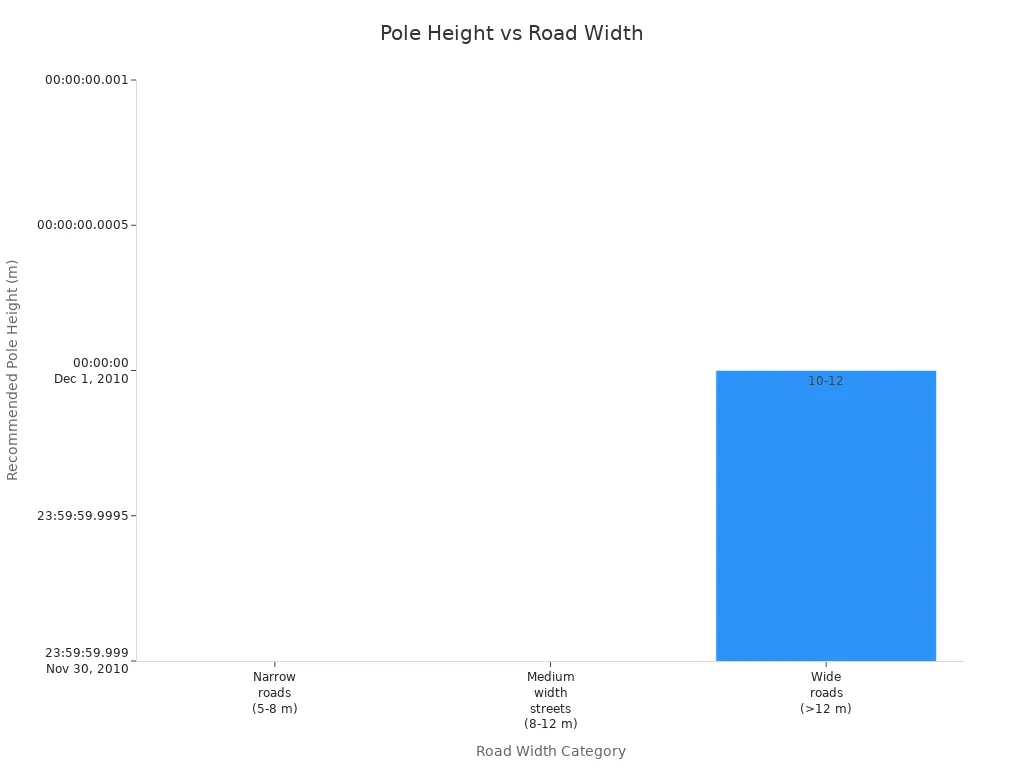
As roads get wider, pole height goes up too. This gives better light and covers more space.
Lighting Requirements
Different places need different amounts of light. Highways and busy roads need brighter and more even light. Streets in neighborhoods and walkways need less. You should match the pole height and led power to the area. The right height gives the best light and spreads it evenly.
| Application |
Pole Height (m) |
LED Power (W) |
Lux Level |
Uniformity Ratio (U0) |
| Pathways/Gardens |
3–4 |
10–30 |
5–10 |
≥0.25 |
| Rural Roads |
5–7 |
30–60 |
5–15 |
≥0.3 |
| Urban Streets |
8–10 |
60–100 |
15–25 |
≥0.35 |
| Highways |
10–14 |
100–200 |
20–30 |
≥0.4 |
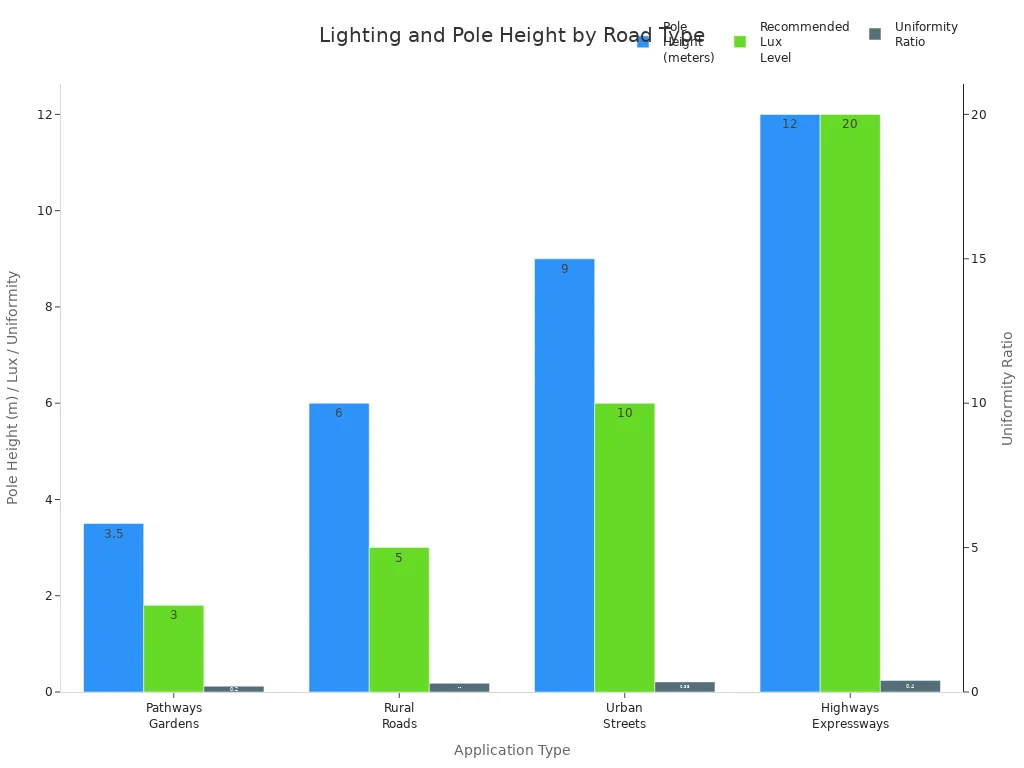
Pick led street lamps with the right power and pole height. This keeps people safe and saves energy. Use the formula H ≥ 0.5R to help choose the height.
Environmental Conditions
Weather and climate matter when picking pole height. Windy places need strong poles and tight mounting. High winds may mean you use shorter poles or tougher materials. In rainy or coastal areas, make sure led and solar panels are waterproof. Change the solar panel tilt to get more sunlight. This can change the best pole height.
Coastal and stormy places need wind-resistant designs.
Pick pole height and spacing for the road and use.
Use waterproof and tough led street lamps for rain.
Tilt solar panels for better sunlight.
Choose models that fit your local weather for longer life.
Thinking about these things helps your solar street lights work well and last longer.
Best Height by Area
Residential Solar Street Lights
You want your neighborhood to feel safe and welcoming at night. The right solar street lights help you achieve this goal. In residential areas, you should use poles between 5 and 6 meters tall. This height fits well with the scale of homes and streets. It also avoids glare and keeps the area looking nice. Most led street lamps in these settings use 30W to 50W. This wattage gives you enough light for sidewalks and driveways without wasting energy.
You should space your solar street lights about 80 to 100 feet apart. This distance ensures even lighting coverage and avoids dark spots. If you use higher wattage, you can increase the spacing a little. Lower wattage means you need to place the poles closer together. Always check for trees or buildings that might block the light. If you see obstructions, you may need to raise the pole height or adjust the spacing.
| Parameter |
Typical Range / Value |
Notes |
| Pole Height |
5 to 6 meters |
Fits residential streets and maintains aesthetics |
| LED Wattage |
30W to 50W |
30W or 40W common; 50W for special needs |
| Fixture Spacing |
80 to 100 feet |
Ensures even lighting coverage |
| LED Lumens Output |
3,000 to 6,000 lumens |
Matches the needs of most neighborhoods |
Tip: Avoid using high wattage led street lamps in residential areas. They can cause glare and require larger solar panels, which may not look good in your neighborhood.
Commercial and Urban Areas
In commercial and urban zones, you need more light for safety and visibility. You should set your solar street light pole installation between 7 and 12 meters high. This range gives you wide lighting coverage and helps prevent shadows in parking lots, shopping centers, and busy streets. Most led fixtures in these areas use 60W to 100W. This power level ensures bright, uniform light for both vehicles and pedestrians.
You should space your solar street lights based on the pole height and wattage. For example, if you use a 10-meter pole with a 100W led, you can space the poles 30 to 40 meters apart. If you have walkways or courtyards, use shorter poles and closer spacing. Taller poles work best for large open spaces like parking lots. Always consider local rules and the presence of trees or tall buildings. These factors may require you to adjust the installation height and spacing.
Set pole height between 7-12 meters for commercial zones.
Use 60W-100W led fixtures for strong, even light.
Place poles 30-40 meters apart for wide roads or lots.
Raise pole height if you need to avoid trees or improve security.
Higher poles also help solar panels get more sunlight and reduce shadows.
Highways and Main Roads
Highways and main roads need the highest solar street lights. You should install poles between 10 and 15 meters tall. This height gives you the best lighting coverage area for fast-moving traffic and wide lanes. Most highways use led fixtures with 60W to 120W. Some expressways use even taller poles, up to 25 meters, with very high output led lamps.
You should space your solar street lights 30 to 50 meters apart on highways. This solar street light distance ensures that drivers see clearly and stay safe. The higher the pole, the farther apart you can place the lights. Always follow transportation authority guidelines for street light height and spacing.
| Authority / Road Type |
Recommended Installation Height (meters) |
LED Wattage (W) |
Typical Spacing (meters) |
| ANSI - Major Roads |
7.6 |
60–120 |
30–50 |
| IES - Highways |
9 |
60–120 |
30–50 |
| General Highway Pole Heights |
9–15 |
60–120 |
30–50 |
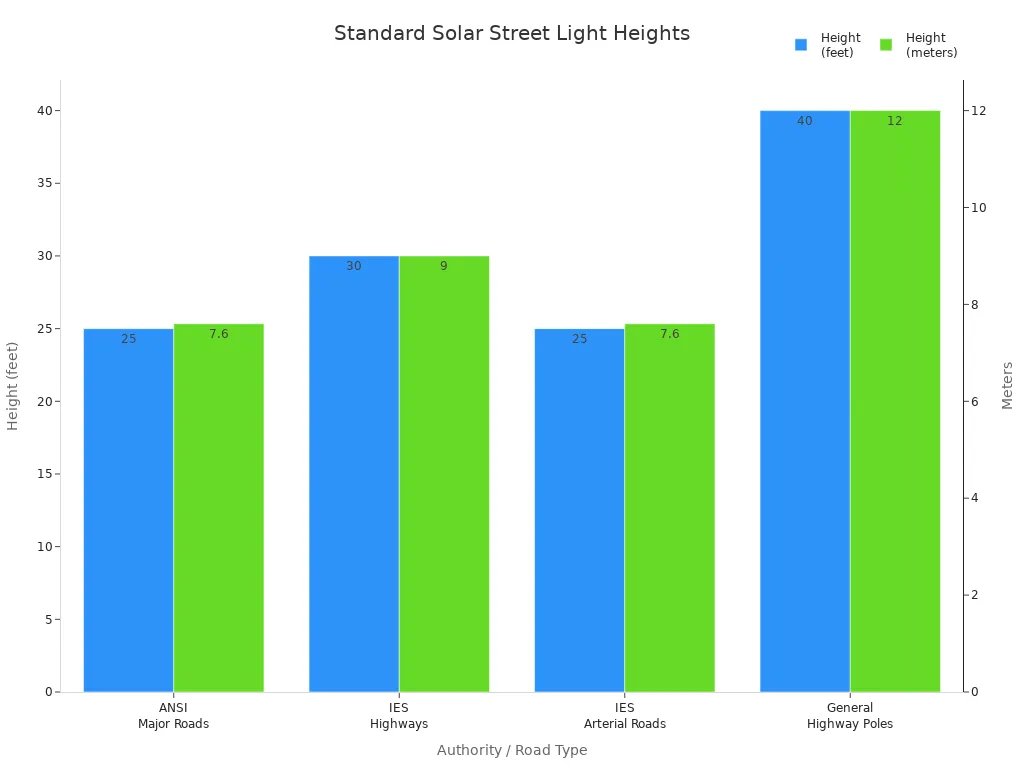
Note: Use strong poles and deep foundations for highway solar street light pole installation. High winds and large lighting coverage area require extra stability.
Parks and Pathways
Parks and pathways need gentle, focused light. You should use poles between 3 and 4 meters tall for most parks and walking paths. This installation height keeps the light close to the ground, making it safe and pleasant for people walking or relaxing. Most led fixtures in these areas use 10W to 30W. This wattage gives enough light without overpowering the natural setting.
If you have trees or tall plants, you may need to raise the pole height to 4-6 meters. This helps the light reach the ground and avoids shadows. You should space your solar street lights 10 to 15 meters apart along pathways. In open park areas, adjust the spacing and height to match the landscape design and avoid dark spots.
| Area Type |
Recommended Installation Height |
LED Wattage (W) |
Typical Spacing (meters) |
| Parks and Pathways |
3–4 meters |
10–30 |
10–15 |
| With Trees/Obstructions |
4–6 meters |
20–40 |
10–15 |
Tip: Always survey your park or pathway before installing solar street lights. Look for trees, hills, or buildings that could block the light. Adjust the installation height and spacing as needed to keep the area well-lit and safe.
Quick Reference Table: Installation Height and Spacing by Area
| Area Type |
Pole Height (meters) |
LED Wattage (W) |
Typical Spacing (meters) |
Notes |
| Residential |
5–6 |
30–50 |
24–30 |
80–100 feet; check for obstructions |
| Commercial/Urban |
7–12 |
60–100 |
30–40 |
Use higher poles for open areas |
| Highways/Main Roads |
10–15 |
60–120 |
30–50 |
Follow authority guidelines |
| Parks/Pathways |
3–4 (4–6 w/trees) |
10–30 (20–40) |
10–15 |
Adjust for trees and landscape design |
Remember: The best solar street light pole installation depends on your area’s needs, local codes, and the presence of obstacles. Always plan your solar street light distance and led wattage to match the lighting coverage area you want.
Installation Height Tips
Adjusting for Obstructions
When you put up solar street lights, look for things that block light. Trees, buildings, or signs can stop the light or shade the solar panel. If there are lots of trees on one side, put lights only on that side. This helps stop leaves from making too much shade. At intersections, do not put lights closer than 10 meters to traffic signs. This keeps the signs easy to see. You can use bamboo sticks at dusk to check if the pole is tall enough. This shows if the light will shine where you want it. Solar panels need 6 to 8 hours of sunlight each day to work best. Always point the panels south if you live in the Northern Hemisphere. Make sure nothing blocks the sun during the brightest part of the day.
Here is a simple chart to help you pick the right pole height for different road layouts:
| Installation Scenario |
Recommended Pole Height Relative to Road Width |
| One-side street light |
Height should be at least equal to the road width |
| Two-side symmetrical street light |
Height should be half of the road width |
| Two-side staggered street light |
Height should be at least 70% of the road width |
Keep poles away from big trees or tall buildings.
Change the pole height if you see shadows during the day.
Think about how trees might grow and block light later.
Local Codes and Regulations
You have to follow local rules when you set up solar street lights. These rules keep your project safe and legal. Most places have a limit for how tall poles can be. For homes, the tallest pole is usually 8 or 12 feet. Stores or factories can use taller poles. Some places need a permit or special check for very tall poles. Always ask your city or county before you start your project.
| Use Case / Structure Type |
Maximum Allowable Height (feet) |
Notes |
| Single- and two-family residential light poles |
8 |
Applies to light poles and accessory structures on site |
| Multi-family and townhouse residential poles |
12 |
Applies to light poles and accessory structures on site |
| Outdoor recreational facility light poles |
60 |
Includes educational facility recreational lighting |
| Non-residential light poles |
18 |
Except industrial uses in Centers for Industry districts |
| Industrial uses in Centers for Industry districts |
50 to 75 |
50 feet max if near residential; up to 75 feet with setbacks |
| Lighting on non-residential structures |
15 |
Measured from first floor elevation |
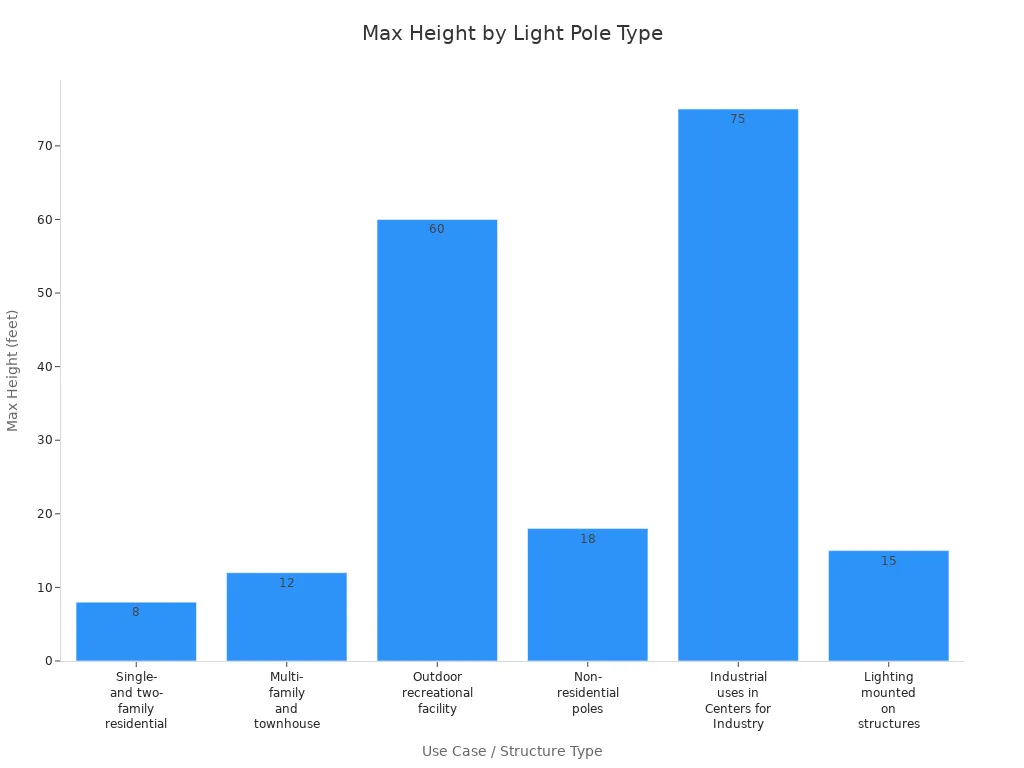
Tip: Always talk to local experts or officials to make sure you use the right pole height.
Weather and Climate
Weather and climate are important when picking the right pole height. In windy places, use shorter poles or stronger materials to keep the lights safe. If you get a lot of snow, use taller poles so snow does not cover the solar panels or led fixtures. In places near the ocean, use poles that do not rust and watch out for salt that can hurt the system. Change the tilt of your solar panels to get the most sun in each season. Tilt them more in winter and less in summer. This helps your led lights work well all year.
Use taller poles in snowy places to keep panels clear.
Pick strong, weather-proof materials for tough weather.
Change pole height and panel angle to get the most energy.
Note: Planning your pole height for weather and local rules helps your solar street lights last longer and give better light.
You can choose the best height for solar street lights by matching the pole to your area and needs. Use shorter poles for pathways and gardens, and taller ones for highways or large spaces. The table below shows common recommendations:
| Setting |
Recommended Pole Height |
Notes |
| Streets |
15-20 feet for narrow streets; 25-50 feet for wide roads |
Wider roads need longer arms to center light. |
| Parks |
Short poles for paths; tall poles for fields |
Lighting improves safety and looks. |
| Commercial Areas |
Short poles for walkways; tall poles for lots |
Height changes by function and security needs. |
Think about area type, lighting needs, weather, and local rules before you install solar street lights. Always check with local experts to make sure your project meets all standards.
FAQ
What happens if you install solar street lights too low?
If you install solar street lights too low, the light covers a smaller area. You may see dark spots between poles. Low poles can also cause glare for people walking or driving nearby.
How do you choose the right pole height for your area?
You should match the pole height to the width of your road or space. For narrow paths, use shorter poles. For wide roads, use taller poles. Always check local rules before you decide.
Can weather affect the best height for solar street lights?
Yes. Strong winds need shorter or stronger poles. Heavy snow means you should use taller poles to keep panels clear. In coastal areas, pick rust-resistant materials. Always plan for your local weather.
Do you need a permit to install solar street lights?
Many places require a permit for new street lights. You should contact your local building office before you start. This helps you follow all safety and zoning rules.

















